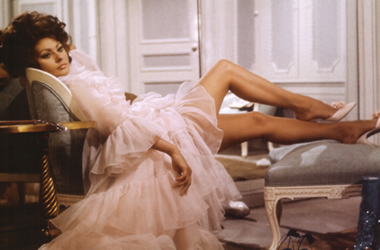A Tribute to Yves Sain Laurent
“The Quiet Prince of Fashion”
By Ruth Carroll
In June 2008, the fashion world lost one of it's most influential couturiers of the 2nd half of the 20th century. After a visit to Yves Saint Laurent, a superb exhibition featured at San Francisco's DeYoung Museum, I decided to further explore the life and career of this iconic fashion designer.
All About Yves
The Yves Saint Laurent exhibition showcases around 130 accessorized garments, in addition to his sketchbooks full of colorful, detailed drawings of his atelier fashions. His designs were inspired from art, nature, history, film and exotic ethnic themes.
All about Yves - Early Life
Yves Mathieu Saint-Laurent was born in Oran, Algeria, which at the time was the capital of a French département. His family was among the most prominent in Oran. His father Charles, a descendant of Baron Mathieu de Mauvières, was the president of an insurance company and the owner of a chain of movie theaters. His mother, Lucienne-Andrée, the daughter of a Belgian engineer and his Spanish wife, passed her sense of fashion and style to her son.
Yves was the oldest child born just over a year after his parents' marriage. Unlike most French children, Yves and his sisters were not directly affected by World War II, as their father was not called up, and Algeria was far enough away from France that it was spared the worst of its defeat and occupation. Yves was bullied while at school; he once told a reporter, “Whenever they picked on me, I’d say to myself, ‘One day I’ll be famous!’ “That was my way at getting back at them”.
In an empty room at his home, he’d act out performances of plays by Molière and Giraudoux for his family. He devoured the theatre reviews in the French magazine Vogue, and became fascinated not only by the descriptions of the play but also by the descriptions of the costumes. This led him to the fashion sections of Vogue, and very soon he was just as interested in fashion design as he was in theatres.
The House of Dior
In 1950 Yves submitted three sketches to a contest for young fashion designers organized by the International Wool Secretariat. He won third prize and was invited to attend the awards ceremony in Paris in December of that year. While he and his mother were in Paris, they met Michel de Brunhoff, editor-in-chief of the Paris edition of Vogue magazine, de Brunhoff an amicable man who encouraged new talent, was impressed by the sketches Yves brought with him and suggested that he consider a course of study at the Chambre Syndicale, the council which regulated the haute couture industry and also provided training to its employees. Yves left Oran for Paris after graduation and began his studies at the Chambre Syndicale, but found the course syllabus frustrating and left after a few months. Later that same year Yves entered the International Wool Secretariat again and won, beating out a young German student named Karl Lagerfeld.
Shortly after his win, he brought a number of sketches to de Brunoff who saw in his designs close similarities to sketches he had been shown that morning by Christian Dior, a leading haute couturier. Knowing that Dior had created the sketches that morning and that Yves could not have possibly seen them, de Brunhoff sent him to Dior, who hired him on the spot. Yves found himself at the age of 21 the head designer of the House of Dior. His spring 1958 collection almost saved the House from financial ruin; the straight line of his creations, a softer version of Dior’s New Look jettisoned him to international stardom with what would later be known as the “trapeze dress”, which included dresses with a narrow shoulder and flared gently at the bottom.
Many of his subsequent collections were received enthusiastically by both his fans and the press. He always used only the highest quality fabric materials for his garments, and many of his styles were considered ground breaking, such as his Spring 1967 collection that introduced the, “Le Smoking”, tailored tuxedo suite. Other collections raised controversy, such as his Spring 1971 collection which was inspired by 1940’s era fashion. Some critics felt that it romanticized the German Occupation, (which Saint Laurent did not himself live through), while others felt it evoked the ugly utilitarianism of the times.
The Rive Gauche boutiques for women were established in 1966, and his men’s wear was added in 1974. He became famous for his gossamer see-through blouses (1968), peasant blouses, bolero jackets, pantsuits, and smocks.
To quote Yves Saint Laurent …”I wanted to serve women, their bodies, their attitudes and gestures, and to support their struggle for liberation over the past century”.
Couture Imitating Art
At the YSL exhibit, I was mesmerized while viewing his original 1960’s black & white Tuxedo suits, I then discovered a magical room displaying his fashions inspired by famous artists. Pablo Picasso’s haute couture Harlequins, Saint Laurent’s whimsical designs drawn from Matisse, and powerfully cubed shapes evocative of Georges Brach. His inspired use of thickly applied fabric, like oils on canvas, in a tribute to Van Gogh’s Sunflowers. He also demonstrated his passion for film & literature, with creations influenced by the avant garde style of Jean Cocteau, and the modernist poetry of Appolinaire.
1966 A Very Good Year
1966 was a very busy and productive year for Saint Laurent. In couture he pioneers his way into ready-to-wear, opening up the YSL Rive Gauche boutique on the ultra chic Rue deTournon in Paris. He then branches out into other artistic areas, drawing comic strips (Naughty Lulu), and creating costumes and stage décor for theatre, which coincidentally he had already been working on earlier in 1959, ballets and films.
Belle DE Jour and Beyond
Following his lifelong fascination with theatre and film, he seemed a natural for introducing his own brand of nouvelle couture to the films of the 1960’s.
Starting as early as 1963 designing costumes for the stunning Claudia Cardinale in, The Pink Panther. In 1966 he creates the brightly mod fashions for Sophia Loren in the Euro, camp thriller Arabesque.
Then in 1967s Belle de Jour, Saint Laurent embarks on the beginning of a lasting collaboration between actress and couturier, with his beautiful muse, Catherine Deneuve. For his work in Luis Bunuel’s classic film, he receives the Harper Bazaar “Oscar” award.
Catherine Deneuve
Sophia Loren in Arabesque
Claudia Cardinale in The Pink Panther
Haute Couture Vs. Prêt-à-Porter
Saint Laurent’s prêt-à-porter line soon became more popular with the public, if not with the critics, eventually becoming more profitable for Saint Laurent and Pierre Bergé (YSL ceo), than the haute couture line. However; Saint Laurent, whose health had been declining over the years, became erratic under the intense pressure of designing two haute couture and two prêt-à-porter collections every year, he turned more to the use of alcohol & drugs.
In 1983, Saint Laurent became the first living fashion designer to be honored by the Metropolitan Museum of Art with a solo exhibition. In 2001, he was awarded the rank of Commander of the Légion d’Honneur by French president Jacques Chirac. He retired in 2002 and became increasingly reclusive, living at his homes in Normandy and Morocco with his pet French Bulldog, Moujik. He also created a foundation with Pierre Bergé in Paris to trace the history of the house of YSL, complete with 15,000 objects and 5,000 pieces of clothing.
Saint Laurent died on June 1,2008 of brain cancer at his residence in Paris. According to The New York Times, a few days before he died, Saint Laurent and Bergé were joined in a same–sex civil union known as a “civil pact of solidarity” in France. He was also survived by his mother and sisters; his father died in 1988.
Saint Laurent’s body was cremated and his ashes were scattered in Marrakech, Morocco in a botanical garden that he often retreated to for inspiration and refuge.
YSL… “My heart has always been divided between the vestals of constancy and the avatars of change”











